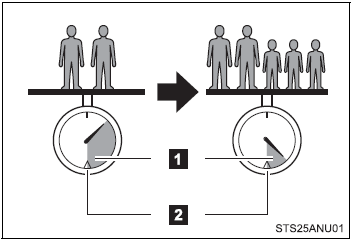 Toyota Yaris: Cargo and luggage
Toyota Yaris: Cargo and luggage
Take notice of the following information about storage precautions, cargo capacity and load:
● Stow cargo and luggage in the luggage compartment whenever possible.
● Be sure all items are secured in place.
● To maintain vehicle balance while driving, position luggage evenly within the
luggage compartment.
● For better fuel economy, do not carry unnecessary weight.
Capacity and distribution
Cargo capacity depends on the total weight of the occupants. (Cargo capacity) = (Total load capacity) − (Total weight of occupants)
Steps for Determining Correct Load Limit—
(1)Locate the statement “The combined weight of occupants and cargo should never
exceed XXX kg or XXX lbs.” on your vehicle’s placard.
(2)Determine the combined weight of the driver and passengers that will be riding
in your vehicle.
(3)Subtract the combined weight of the driver and passengers from XXX kg or XXX
lbs.
(4)The resulting figure equals the available amount of cargo and luggage load capacity.
For example, if the “XXX” amount equals 1400 lbs. and there will be five 150 lb
passengers in your vehicle, the amount of available cargo and luggage load capacity
is 650 lbs. (1400 − 750 (5 × 150) = 650 lbs.)
(5)Determine the combined weight of luggage and cargo being loaded on the vehicle.
That weight may not safely exceed the available cargo and luggage load capacity
calculated in Step 4.
(6) If your vehicle will be towing a trailer, load from your trailer will be transferred
to your vehicle. Consult this manual to determine how this reduces the available
cargo and luggage load capacity of your vehicle.
Except 3-door models for Canada:
Toyota does not recommend towing a trailer with your vehicle. Your vehicle is not designed for trailer towing.
Calculation formula for your vehicle

 Cargo capacity
Cargo capacity
 Total load capacity (vehicle capacity
weight) (→P. 342)
Total load capacity (vehicle capacity
weight) (→P. 342)
When 2 people with the combined weight of A lb. (kg) are riding in your vehicle, which has a total load capacity (vehicle capacity weight) of B lb. (kg), the available amount of cargo and luggage load capacity will be C lb. (kg) as follows:
B*2 lb. (kg) − A*1 lb. (kg) = C*3 lb. (kg)
*1: A = Weight of people
*2: B = Total load capacity
*3: C = Available cargo and luggage load
In this condition, if 3 more passengers with the combined weight of D lb. (kg) get on, the available cargo and luggage load will be reduced E lb. (kg) as follows:
C lb. (kg) − D*4 lb. (kg) = E*5 lb. (kg)
*4: D = Additional weight of people
*5: E = Available cargo and luggage load
As shown in the example above, if the number of occupants increases, the cargo and luggage load will be reduced by an amount that equals the increased weight due to the additional occupants. In other words, if an increase in the number of occupants causes an excess of the total load capacity (combined weight of occupants plus cargo and luggage load), you must reduce the cargo and luggage on your vehicle.
CAUTION
■Things that must not be carried in the luggage compartment
The following things may cause a fire if loaded in the luggage compartment:
●Receptacles containing gasoline
●Aerosol cans
■Storage precautions
Observe the following precautions. Failure to do so may result in death or serious injury.
●Stow cargo and luggage in the luggage compartment whenever possible.
●Do not stack cargo and luggage in the luggage compartment higher than the seatbacks.
Such items may be thrown about and possibly injure people in the vehicle in the
event of sudden braking or in an accident.
●Do not place cargo or luggage in or on the following locations as the item may
get under the clutch, brake or accelerator pedal and prevent the pedals from being
depressed properly, block the driver’s vision, or hit the driver or passengers,
causing an accident:
• At the feet of the driver
• On the front passenger or rear seats (when stacking items)
• On the luggage cover
• On the instrument panel
• On the dashboard
●Secure all items in the occupant compartment, as they may shift and injure someone
in the event of an accident or sudden braking.
CAUTION
●When you fold down the rear seats, long items should not be place directly behind
the front seats.
●Never allow anyone to ride in the luggage compartment. It is not designed for passengers.
They should ride in their seats with their seat belts properly fastened. Otherwise,
they are much more likely to suffer death or serious bodily injury, in the event
of sudden braking or an accident.
■Capacity and distribution
●Do not exceed the maximum axle weight rating or the total vehicle weight rating.
●Even if the total load of occupant’s weight and the cargo load is less than the
total load capacity, do not apply the load unevenly. Improper loading may cause
deterioration of steering or braking control which may cause death or serious injury.
 Vehicle load limits
Vehicle load limits
Vehicle load limits include total load capacity, seating capacity, towing
capacity and cargo capacity.
■ Total load capacity (vehicle capacity weight): (→P. 342)
Total load capacity me ...
See also:
Tire inflation pressure
■ Tire inflation pressure
The recommended cold tire inflation pressure and tire size are displayed on the
tire and loading information label. (→P. 351)
■ Inspection and adjustm ...
If you have a flat tire
Remove the flat tire and replace it with the spare tire provided.
■ Before jacking up the vehicle
● Stop the vehicle on a hard, flat surface.
● Set the parking brake.
● Shi ...
Outside rear view mirrors
Mirror angle can be adjusted.
Vehicles with a manually adjustable type
Adjust the mirror up, down, in or out by pushing the mirror surface.
Vehicles with a power-adjustable type
To select a mi ...

